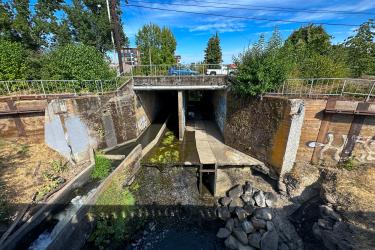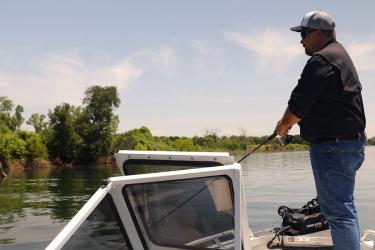This sitrep starts from Day 1 in Construction Time (the day the construction crew fully arrived at Cape Shirreff); the epic offload has already been reported by our Science Team.
Days 1–3
We hit the ground running. When we all finally arrived to Cape Shirreff we picked out our tents, and threw our bags in our vestibules. It was sure nice that the Science Team had our tents waiting for us, but we didn’t bother to unpack. We got straight to work because the weather was beautiful.
We spent most of our first three days of Construction Time (which is different from Real Time and feels more like a Dog Year) setting the foundations for the two buildings we are erecting this season: the “galley” and the “berthing suite.” Setting foundations included several operations, including driving twenty 4-ft steel stakes that weigh about 40 lbs each into the ground as guy points for the two buildings. The difference between these stakes and your average every day tent stake is similar to the difference between a Hot Wheel and an actual car. We set a bunch of foundation pads, cut the posts rising from those pads to the right height using a laser level and attached the drop beams that both buildings sit on.
After the drop beams were level we set the floor panels – these are SIPs (Structural Insulated Panels) each about 12 inches thick. The SIPs look like giant ice cream sandwiches. The largest floor SIPs weigh about 200 lb (amazing to think we somehow got all this to shore in Zodiacs). By the end of Day 3 we pretty much had both floors set.
Days 4–6
Days 4 and 5 were spent constructing exterior walls on both buildings. These are also SIPs (only about 6 inches thick and generally not as heavy as the floors. To erect the walls, we had to be sure the floors were square, level, etc. It turns out that the galley was about 1.5 inches shorter here in Antarctica than during the prefab in Denver. How does that happen? We figure that the crew here is simply stronger after all the sledge hammer work driving in those monster stakes, and we fitted all the floor SIPs together tighter than what was done in Denver – who knows, but if we averaged only 1/8 inch tighter across 12 SIPs that would explain the 1.5 inch difference.
Every piece of wood that originates in Denver and ends up at Cape Shirreff swells mightily from all the moisture here. Fitting all the SIPs together has required that we set up a small sawmill here at the Cape. We have been ripping about 1/8 to 3/8 of an inch from every plank and also beveling all the edges of the lumber that ties all the SIPs together.
A huge storm rolled through on Day 6. Several of us started our day at 0200 scrambling around camp trying to be sure that our tents and other things weren’t blowing away in the 50 knot gusts. It was too windy to work on Day 6 so we spent the day planning, recovering, and doing a little bit of guided hiking around the Cape. Some of us used our hike to scout the site of next year’s build - the Cape Shirreff bird blind and emergency shelter.
Days 7–9
By the end of our first week in Construction Time, we were finishing exterior walls and working on interior walls and other structural pieces. Production from our sawmill, nicknamed The Fur Seal Sawmill, was strong (of course we have been taking all possible steps to contain and collect the sawdust and shavings from our mill). Our buildings were starting to look and feel like buildings now. It is pretty amazing to walk up to a “window to be” and look through it to see the views around Cape Shirreff – the students at CBW nailed this one! The views from the buildings are simply amazing; it is hard to put into words what it feels like to imagine standing at the to-be stove cooking a meal and looking at the slope of Condor Hill fall into the sea along a fur seal breeding beach with a big glacier in the background.
By the end of Day 9 the 1st half of roof SIPs were up on berthing. These SIPs are also about 12 inches thick, and lifting these big panels anywhere from 12-16 feet in the air is a trick – all done by hand via scaffolding.
Days 10–12
On Day 10 we finished installing roof SIPs on the berthing suite! That felt like a huge accomplishment. We also started to really waterproof the building, but we didn’t quite finish in time to prevent the evening’s rain shower from wetting the interior a bit.
Day 11 was tough. The weather went from yucky to worse, and although we tried to place SIPs on the galley roof, we called the operation off after only setting two on the roof because it just didn’t feel safe with the increasing wind and our general fatigue. Almost everyone fell asleep at the lunch table! After lunch we did a few other tasks lower to the ground and that did not require moving materials with a lot of sail area (e.g., installing waterproofing, flashing, and the battens needed to mount exterior cladding on the berthing suite). We also started installing windows in the berthing suite. Ultimately we ended the day a little earlier than usual; the two hours of extra rest was really needed.
Day 12 marked an important milestone – both buildings were officially “topped out” by the end of the day (both buildings had all roof SIPs in place). We were lucky to have a mostly clear day with light winds, and our “roof team” was able to finish installing all roof SIPs on the galley! We all used permanent ink pens to sign the last SIP before it was set into place. We also managed finish installing windows and the front door in the berthing suite as well as about half the windows in the galley. The galley was now starting to offer some shelter from the wind (though it was still cold because several large windows and the front door had not yet been installed), and we used the opportunity to have dessert in our to-be dining area with the Science Team. The dessert was amazing ice cream hand made by David and Ellie, and as we were eating the ice cream we enjoyed watching a brief Antarctic snow flurry.
Life in the Construction Crew
Our days basically go from food (breakfast at 0730) to work to food (lunch at 1300) to work to food (dinner at 1900) to bed. Rinse and repeat. We are eating more calories per person per Construction Day than most of us probably eat in three Real Time days. Our chef (Rene Menz) is such an important member of our team, and there have been many times somebody has said “this is the best camp food I’ve ever had!” Here is a sample of menu items: Moroccan chicken, fish & chips, sautéed scallops and shrimp over linguini, Mexican lasagna, salmon with chutney, gumbo, BBQ chicken, congrio, spaghetti, chicken fingers with mac & cheese, leg of lamb with roasted veggies, Indian and Thai curries, and salad (but our fresh lettuce is about gone!). Rene has done more things with pumpkin than any of us knew was possible. All our meals are accompanied by fresh made bread, and a new cauldron of soup emerges every day. What would we do without Rene!
And there is Ellie and David, the two people who somehow keep our camp working while the rest of us are building. It takes a lot of work to make sure our camp stays safe, clean(ish) and squared away with working generators and taught tents. Ellie and David do all this – it’s like magic, things just work, and they work better and better every day.
We all sleep in tents, except Rene who sleeps in a room adjoining our kitchen (our Chilean colleagues at INACH are kindly letting us use their kitchen because they are not here at the Cape this year). Thanks to our friends at the National Science Foundation, we each sleep in our own tent. Tent camping in Antarctica is definitely an experience. It is simultaneously exhilarating and exhausting. Some nights sleep is more of an aspiration than a reality – when the wind blows the tents are very noisy. All in all though, it is very nice to have a private place to lay down every evening.
We start each day with a weather check (well we check the weather as often as we can) and plan our day’s activities from there. After breakfast we gather together and stretch. Then we break into smaller teams and start tackling the various tasks that need to be done. Everyone lends a hand whenever one team needs more muscle.
We have fun visiting with the Science Team, and the camaraderie between the two groups is great. We couldn’t ask for better.
Until next time (we will write future sitreps when we aren’t otherwise building, eating, or sleeping) - the Cape Shirreff Construction Crew (Rick, Shaggy, (Good) Will, Sam (Soup), Fili, Cody, Bo, Kristina, Dre, Geoff, David, Ellie, and George).



